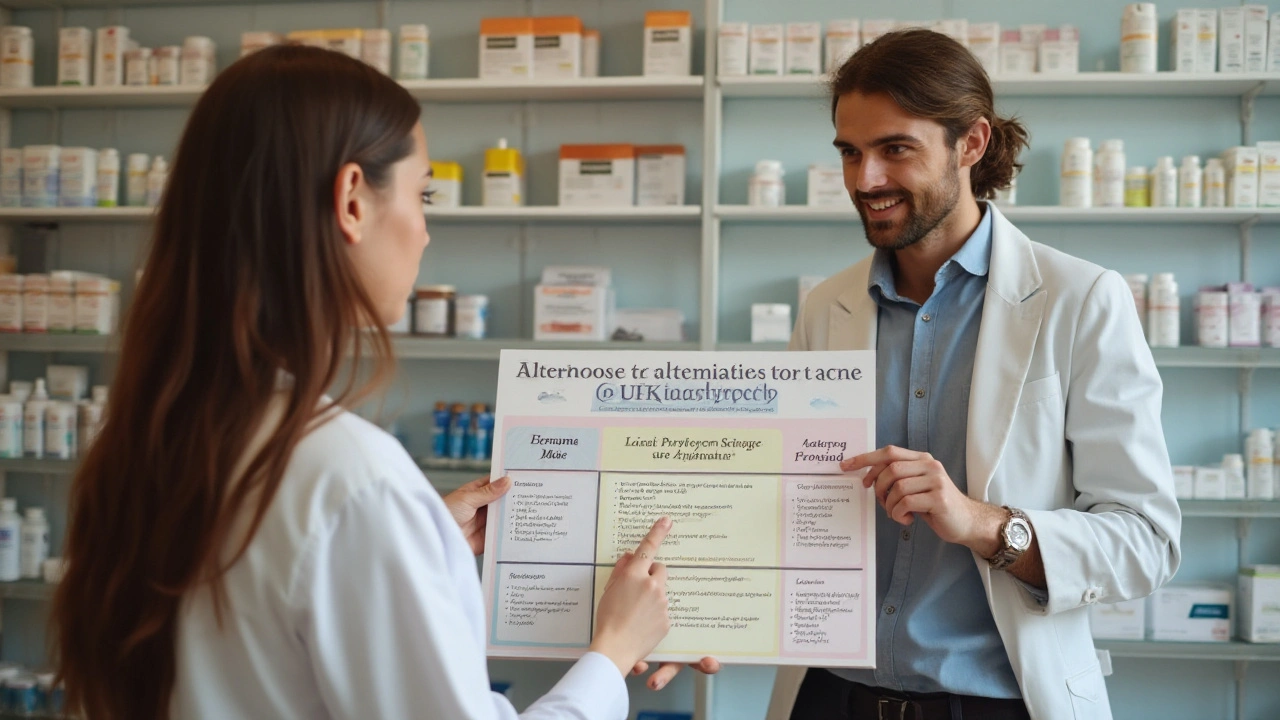 27
Oct,2024
27
Oct,2024
When it comes to treating bacterial infections and acne, Vibramycin has been a popular choice. However, did you know there are several alternatives available? These alternatives cater to different conditions and offer a variety of pros and cons, depending on what you need. From powerful antibiotics to innovative acne treatments, this article explores nine alternatives that you might consider.
It's important to understand each option, weighing both the benefits and potential downsides. This guide is designed to provide a comprehensive overview, empowering you to make an informed decision about your treatment plan. Let's dive into the world of Vibramycin alternatives and discover what each can offer you on your journey to better health.
- Minocin (minocycline)
- Seysara (sarecycline)
- Sumycin (tetracycline)
- Tygacil (tigecycline)
- Declomycin (demeclocycline)
- Aldactone (spironolactone)
- Clindamycin
- Retin-A (tretinoin topical)
- Accutane (isotretinoin)
- Conclusion
Minocin (minocycline)
Minocin, known scientifically as minocycline, is a tetracycline antibiotic that has stood the test of time in treating bacterial infections. It's particularly favored for its effectiveness against a broad range of infections, making it a robust choice when battling conditions like acne, respiratory tract infections, and even some sexually transmitted diseases. For those grappling with Lyme disease or needing a prophylactic treatment, Minocin steps in as a viable option, displaying its versatility in medical treatments. Its popularity isn't just due to its broad application but also its ability to be used in outpatient settings, thus offering convenience for patients who prefer at-home treatment where possible.
The science behind Minocin is fascinating. As a second-generation tetracycline, it boasts improved absorption compared to its predecessors. This makes it a powerhouse against bacteria, effectively interfering with bacterial protein synthesis. Its ability to penetrate tissues gives it an edge, especially in treating conditions where other antibiotics may falter. However, as with any medication, Minocin isn't without its cautionary tales. Users have often reported side effects such as dizziness, rash, and gastrointestinal discomfort, which can be a hurdle for some. It's also noteworthy that Minocin isn't recommended for children under 8 years old due to its potential effects on tooth discoloration and bone growth.
Pros
- Effective for a wide range of infections
- Suitable for outpatient treatment
- Useful in Lyme disease prophylaxis
Minocin's multiple advantages position it as a go-to treatment in general practices and specialized clinics alike. Its ability to tackle a variety of bacteria allows healthcare providers to prescribe it with confidence for diverse conditions. Minocin's effectiveness in community-acquired pneumonia illustrates its reliability and has been supported by numerous studies worldwide. Clinicians, therefore, keep Minocin in their antimicrobial arsenal, ensuring they have an adaptable solution for patient needs.
Cons
- May cause nausea, dizziness, and rash
- Not recommended for young children
- Potential for tooth discoloration and bone growth inhibition
While Minocin is powerful, its potential side effects are important to consider. The issues of dizziness and gastrointestinal conditions may be manageable for some but problematic for others. Parents and physicians need to weigh the benefits against the risks when considering Minocin for younger ages. Understanding these nuances helps create a well-rounded view of Minocin's practical application in medicine. Balancing these factors allows both doctors and patients to make informed choices.
Seysara (sarecycline)
Seysara, known scientifically as sarecycline, is a newer player in the field of tetracycline antibiotics, primarily tailored for the treatment of moderate to severe acne. Introduced not too long ago, it has carved its niche thanks to its specificity against acne-causing bacteria. Its mechanism of action involves inhibiting protein synthesis in bacteria, which effectively starves the microorganisms, reducing their numbers and the skin issues they cause. In many ways, Seysara represents a significant advance in dermatological therapy, focusing on the root causes of acne rather than just the superficial signs.
Designed specifically for acne, Seysara is often hailed for its targeted approach. Unlike some broader-spectrum antibiotics, it doesn't indiscriminately attack beneficial bacteria in the gut, which means fewer gastrointestinal disturbances. This aspect often appeals to patients and doctors alike, as it differentiates Seysara from older antibiotics often used in acne treatment. Clinical trials have shown that sarecycline provides a favorable safety profile, with fewer side effects compared to its predecessors. This makes it an attractive option for many patients who may be sensitive to other medications.
Sara Johnson, a renowned dermatology expert, states, "Seysara offers a sophisticated, targeted approach to acne therapy that embraces the advances in molecular medicine we've made over the past decade."
However, like any medication, Seysara is not without its drawbacks. Despite its focus, some users report experiencing nausea, vomiting, diarrhea, and a notable increase in sensitivity to sunlight. These side effects, while typical of many tetracyclines, might limit its usability for those who spend significant time outdoors. Dermatologists often recommend protective measures like sunscreen and protective clothing during treatment to mitigate these effects.
One of the unique features of Seysara is its narrower antibacterial spectrum. This can be seen as both a pro and a con. On the positive side, it means less disturbance to the body's normal bacterial flora. On the downside, it means Seysara is less effective against infections other than acne. Therefore, while it might be a superior choice for someone battling long-term acne issues, it may not be suitable for those who also need treatment for other types of bacterial infections. It's important to have a thorough discussion with a healthcare provider about the specific needs and circumstances of the patient before starting on Seysara.
Sumycin (tetracycline)
Sumycin, more commonly known as tetracycline, is a Vibramycin alternative that has been a staple in the medical world for decades. This antibiotic is classified as a broad-spectrum antibiotic, which means it is designed to handle a wide range of bacterial infections, making it an appealing choice for many conditions. The mechanism of Sumycin lies in its ability to inhibit protein synthesis in bacteria, effectively halting their growth. Doctors have favored Sumycin for tackling respiratory infections, urinary tract infections, and skin infections, making it a versatile option in the healthcare arsenal.
Its accessibility and variety in formulations -- from capsules to liquid form -- make it a convenient choice for both patients and healthcare providers. Those with an aversion to swallowing pills can use liquid forms, ensuring that the treatment is accessible for all demographics. Despite its longstanding use, it's crucial to be aware that Sumycin is not recommended for children younger than eight due to concerns over tooth discoloration and the potential for slowed bone growth. However, for those eligible, it provides a solid line of defense against infections.
Pros
- Effective for a wide range of infections, offering physicians a go-to choice for their efficacy.
- Available in multiple forms to accommodate different patient needs, making it an inclusive antibiotic compared to others.
- Proven track record spanning several decades, which contributes to trust amongst healthcare professionals and patients.
Many have relied on Sumycin not only for its availability but also for its effectiveness. Medical practitioners appreciate its broad-spectrum capabilities, which means fewer tests are necessary to identify specific bacteria before treatment can begin. This ability to act quickly is crucial in preventing minor infections from developing into serious conditions. Moreover, its affordability and availability in generic forms make it a cost-effective choice for many patients around the world. That said, the usual caution with antibiotics applies; over-prescription or misuse can lead to resistant bacterial strains, which is a growing concern globally.
The World Health Organization emphasizes, "Antibiotic resistance is one of the biggest threats to global health, food security, and development today." Using antibiotics like Sumycin responsibly is as important as the benefits they provide.
Cons
- May cause gastrointestinal side effects like nausea, vomiting, and diarrhea, which can be troublesome for some users.
- Photosensitivity is a concern, meaning users should avoid excessive exposure to sunlight or artificial UV rays to prevent skin reactions.
- Potential for dental and skeletal side effects in children, firmly limiting its use to adults or older children only.
While Sumycin is a trusted name among antibiotics, users should exercise precaution when following prescriptions. It's essential to complete the full course of treatment to ensure all bacteria are effectively eradicated and to prevent resistance. It's necessary to have a healthcare provider monitor treatment, especially if side effects become pronounced. The convenience and accessibility of Sumycin make it a truly viable alternative to Vibramycin, suitable for those who require a flexible antibiotic solution.

Tygacil (tigecycline)
Tygacil, known generically as tigecycline, is a broad-spectrum antibiotic that has become a vital tool in the fight against severe bacterial infections. It's classified as a glycylcycline antibiotic, which is a subclass of the tetracycline antibiotics, yet it boasts an impressive efficacy against various strains. This includes those stubborn strains resistant to other antibiotics, making it a strong contender in treating complicated skin and intra-abdominal infections, as well as community-acquired bacterial pneumonia.
Tygacil is administered via intravenous infusion, which means it is typically reserved for hospital settings where critical infections are managed. This method of administration ensures that the antibiotic starts working swiftly, reaching peak blood levels quickly to combat tough infections. With Tygacil, patients receive a drug with a broad reach that can handle a diverse array of bacterial pathogens. Hospitals often keep Tygacil in their arsenal due to its ability to treat infections when other medications fall short.
Notably, Tygacil's efficacy has been robust against resistant bacteria, such as Methicillin-resistant Staphylococcus aureus (MRSA) and Vancomycin-resistant Enterococcus (VRE). This is a key reason why it is chosen for critically ill patients facing formidable bacterial threats. Though its strength is evident, Tygacil's use is balanced by some considerations. A unique aspect of its profile is the increased risk of mortality in certain situations, which means healthcare providers weigh benefits against potential risks. Such decisions often require the discernment of experienced medical personnel to ensure it's the right fit for the patient in question.
Pros
- Effective against a wide range of bacteria, including resistant strains.
- Useful in treating severe infections in hospital settings.
- Administered intravenously for rapid action.
Cons
- May cause nausea, vomiting, and diarrhea.
- Associated with increased risk of mortality in severe cases.
- Not suitable for less severe infections.
Despite its strengths, Tygacil is not a panacea. It cannot be used for every patient or for infections that are deemed mild or non-life-threatening. It shines in scenarios where the stakes are high, and alternatives are limited. Looking at its track history, one can see how Tygacil has effectively filled a niche, offering hope in the fight against stubborn bacterial invaders. Ultimately, while Tygacil isn't the first line of defense, it's an invaluable backup that healthcare providers turn to when faced with dire situations.
Declomycin (demeclocycline)
Declomycin, known by its active compound demeclocycline, is a tetracycline antibiotic utilized for its effectiveness against a variety of bacterial infections. This drug stands out not only for its role in handling skin infections and acne but also for its unique application in treating certain cases of SIADH (Syndrome of Inappropriate Antidiuretic Hormone). In the realm of antibiotics, Declomycin is often considered a reliable choice due to its broad range of activity and ability to impede bacterial protein synthesis. This makes it an essential component in the treatment of infections that other antibiotics might not effectively address.
The administration of Declomycin usually involves oral tablets, and the dosage frequency is determined by the type and severity of the infection being treated. Patients are generally advised to take it on an empty stomach to enhance absorption, avoiding dairy products which can interfere with its efficacy. A fascinating aspect of Declomycin is its lesser-known function in disrupting the action of certain hormones in the kidneys, making it useful in treating SIADH, a condition where the body retains too much water and dilutes blood sodium levels. This dual-action characteristic distinguishes it from other antibiotics in its class.
Despite its strengths, Declomycin is not without its pitfalls. Users need to be wary of the potential side effects, which can include nausea, vomiting, and increased photosensitivity. It's crucial for patients to understand these risks, as misuse can lead to adverse impacts. Due to its tetracycline nature, it is not recommended for young children or pregnant women because it can cause tooth discoloration and potentially impact bone growth. This age restriction underscores the importance of conscious prescribing and reinforces the need for healthcare providers to balance benefit-risk ratios carefully.
According to Dr. Allen Rogers, "When choosing an antibiotic like Declomycin, it's essential to weigh its antibacterial spectrum against the side effect profile for each patient individually."
For individuals exploring antibiotic options, understanding the characteristics of Declomycin can provide clarity in making health decisions. Although alternatives like Vibramycin or Seysara might be more suitable for specific infections, those dealing with conditions such as SIADH may find Declomycin particularly beneficial. It’s always key to engage in thorough discussions with healthcare professionals when considering antibiotics to ensure that the chosen medication aligns with health goals and personal medical history.
Aldactone (spironolactone)
Aldactone, known scientifically as spironolactone, plays a unique role in the realm of treatments. While not an antibiotic, it finds its strength as a diuretic. Its main use is in treating conditions like edema, hypertension, and hyperaldosteronism, making it a versatile option in the healthcare toolkit. What sets Aldactone apart is its ability to manage fluid retention without causing potassium loss, which is a common side effect of other diuretics. It's pretty handy, especially for those who need a gentle approach to balance fluid levels but also need to maintain their electrolyte equilibrium.
This intriguing compound, by blocking certain hormones like aldosterone, helps prevent the body from holding onto excess salt and water. By facilitating this gentle flushing process, it becomes useful not just for typical heart issues but also when hormonal skin conditions are a concern. Although primarily it's not a treatment for bacterial infections, it can be quite effective in some acne management cases due to its hormone-balancing properties. For this reason, some dermatologists might prescribe Aldactone for severe acne when hormones are suspected to be the root cause.
"Aldactone is often the unsung hero in cases where fluid management is crucial yet gentle is the call of the day," says Dr. Michele Green, a renowned dermatologist.
Its benefits are well noted; however, using Aldactone needs a clear conversation with your doctor about what it can and cannot do. It's important to have realistic expectations and a full understanding of potential side effects. Some users experience increased potassium levels, which, if left unchecked, could lead to complications. There's also a chance of experiencing skin issues, gastrointestinal disturbances, or hormonal side effects. Effectively, while it's not directly tackling the bacteria like a traditional antibiotic would, its use in skin therapies, where hormones play a profound part, cannot be ignored.
Interestingly, Aldactone is used in a variety of treatments, offering versatility that spans specialties. Its role in controlling high blood pressure is particularly significant. By facilitating fluid excretion without devastating potassium levels, it makes an excellent partner in cardiovascular health management. As with any medication, close monitoring is key, especially with electrolytes. Doctors typically recommend regular blood tests to ensure that potassium levels remain within safe limits while on this medication.
While Aldactone may not immediately come to mind when discussing Vibramycin alternatives, its impact in certain medical niches highlights the broad spectrum of treatment strategies available to those in need. Whether it's for its understudy role in acne treatment or its firm place in heart health, Aldactone remains a vital tool in both general practice and specialized healthcare. Thus, understanding how each medication fits into your treatment plan can ensure a balanced and holistic approach to managing health concerns. It is always wise to have candid consultation with healthcare professionals to determine if Aldactone could be part of the right solution for your unique medical needs.

Clindamycin
Clindamycin, a member of the lincosamide class of antibiotics, stands out for its efficiency in battling a wide variety of bacterial infections. It's a staple in the medical arsenal against infections of the skin, respiratory tract, and even dental-related issues. Originally derived from a naturally occurring compound found in soil bacteria, Clindamycin was synthesized to enhance its clinical effectiveness. Over the years, it has become a favored choice for its broad-spectrum capabilities and effectiveness even against some antibiotic-resistant strains.
The way Clindamycin works is by inhibiting the synthesis of essential proteins in bacteria, crippling their ability to multiply and cause infection. This mode of action makes it particularly useful in treating stubborn infections where other antibiotics might fall short. It's an asset in dental procedures, especially for patients with specific heart conditions that make them susceptible to bacterial endocarditis. This preventive use of antibiotics during dental work remains a critical application of Clindamycin.
As noted by the respected Mayo Clinic, "Clindamycin is particularly valuable in dental practices due to its penetration capabilities in bone and soft tissues, making it ideal for dental abscess management."
Despite its benefits, Clindamycin is not without drawbacks. Some patients experience gastrointestinal issues such as nausea and diarrhea, with a significant side effect being the risk of C. difficile-associated diarrhea, a severe form of colitis. This condition arises because Clindamycin can disrupt the normal bacterial flora of the gut, paving the way for C. difficile overgrowth. Consequently, healthcare professionals weigh these risks before prescribing it, ensuring it's the most appropriate treatment for the patient's condition.
The use of Clindamycin has also extended into the treatment of certain staphylococcal and streptococcal infections, especially in patients who have allergies to penicillin. Its role in treating osteomyelitis, an infection of the bone, highlights its ability to penetrate into the bone tissue effectively — a feat not all antibiotics can achieve. In cases of surgical site infections, Clindamycin often steps in as a reliable option when methicillin-resistant Staphylococcus aureus (MRSA) is suspected or identified. Clindamycin's versatility makes it invaluable, but guidelines urge its use be judicious, only when clearly indicated, to prevent contributing to the growing problem of antibiotic resistance.
The dose of Clindamycin can vary significantly based on the infection's type and severity, and its delivery method too — whether orally or intravenously — depends on how fast an effect needs to be achieved. In oral form, it is typically taken in capsule form, but it can also be applied topically to treat acne. The topical formulation is often favored to avoid systemic side effects, allowing patients to benefit from its infection-fighting abilities without the typical adverse reactions.
Retin-A (tretinoin topical)
In the world of skincare, Retin-A, also known by its scientific name, tretinoin, stands as a formidable solution targeting acne and aging. Originally developed as an acne medication, Retin-A soon revealed its incredible potential to rejuvenate skin, tackling issues like fine lines, discoloration, and rough skin texture. Tretinoin is a derivative of vitamin A, a crucial nutrient for skin health and cellular turnover, widely recognized for breathing new life into dull skin. Its mechanism involves accelerating the shedding of old skin cells while fostering the growth of fresh ones, granting you a more youthful appearance.
When you apply tretinoin topically, it goes to work by interacting with skin cell receptors, enhancing collagen production while unclogging pores. This dual-action mode makes it exceptionally effective not only for treating acne but also for preventive skincare. The journey to clearer skin with Retin-A, though rewarding, requires patience and commitment. It’s especially important to follow a dermatologist's guidance, as it can initially cause irritation, redness, or peeling as your skin adjusts to the treatment. Despite these common side effects, many users find that the results are well worth the initial discomfort, reporting a significant improvement in their skin’s clarity and texture.
For individuals grappling with persistent acne that hasn’t responded to other treatments, Retin-A could be an invaluable resource. In some cases, it is used in conjunction with antibiotics to maximize results, especially for severe acne. While it does not address bacterial infections directly, combining it with an oral or topical antibiotic can create a robust acne-fighting regimen. This combination therapy approach harnesses the strengths of each medication, addressing both the underlying bacteria and the physical manifestations of acne. A clinical insight revealed,
"Incorporating Retin-A into acne treatment protocols has been a game changer, showing significant results in reducing acne lesions and improving skin health over time."However, it's not just acne sufferers who benefit from this wonder cream.
Interestingly, Retin-A's ability to enhance cell turnover rates means it's also a beloved tool among those looking to mitigate sun damage or signs of aging. As skin ages, the natural turnover process slows down, causing a build-up of dead skin cells on the surface. This can lead to a rough or dull appearance. With tretinoin, users often see a noticeable brightening of their complexion as new, healthier cells come to the forefront. Additionally, by boosting collagen production, Retin-A can help soften fine lines and wrinkles, making it an anti-aging powerhouse. Some users may experience what’s known as the "Retin-A purge," where breakouts initially worsen before dramatically improving, aligning with the treatment flushing out impurities.
In terms of application, Retin-A should be used with considerable care, especially when it comes to sun exposure. Tretinoin can increase skin's sensitivity to sunlight, which underscores the importance of applying a high-SPF sunscreen daily, regardless of the weather. Starting with a small quantity, usually a pea-sized amount, applied nightly, helps mitigate initial dryness and irritation. Gradually increasing usage as the skin acclimates can foster better outcomes. It’s this careful, measured approach that often distinguishes those who achieve stellar results from those who struggle with ongoing irritation. The transformation with Retin-A takes time; it’s the slow and steady march to better skin that pays off.
Accutane (Isotretinoin)
Accutane, also known by its scientific name isotretinoin, is a potent option for tackling severe acne. It stands out due to its unique approach—it doesn’t just target bacterial infections but works by drastically reducing sebum production in the skin. This is significant because less oil can lead to fewer acne breakouts. While this treatment isn't the first line of defense in most acne cases, it’s often prescribed when other methods have failed to make a difference.
A curious aspect of Accutane is its journey from inception to its prominent role in dermatology today. Initially introduced as a chemotherapy drug due to its strong effects on cell growth, it found its niche in treating severe acne and has revolutionized care for patients with conditions like cystic acne. Despite its efficacy, Accutane is not without risks. It’s known for serious side effects which can include birth defects, depression, and even increased pressure on the brain, a condition known as intracranial hypertension. Because of these potential risks, Accutane is subject to strict regulations, and it is crucial that users are well-informed about these aspects before starting treatment.
Research shows that about 85% of patients who complete a full course of Accutane experience significant improvements, with many seeing clear skin for several years or longer after finishing treatment. Dermatologists usually reserve Accutane for the most difficult cases due to its side-effect profile, and its use requires regular check-ups to monitor the patient’s response and any adverse effects. For anyone considering this treatment, discussing the pros and cons with a qualified dermatologist is key.
"Accutane can be transformative for patients with severe acne, but it must be prescribed with caution," advises Dr. Marie Jovanovic, a leading dermatologist with extensive experience in acne treatment.
Another reason Accutane stands out is its stringent usage protocol. Due to the potential for severe side effects, strict measures are in place. For example, women of childbearing age must adhere to rigorous contraceptive protocols to prevent pregnancy during treatment. The drug also often necessitates regular blood tests to keep track of cholesterol and liver function, ensuring the body is coping well with the medication. These steps, while perhaps daunting, are pivotal in minimizing risks and ensuring a safe and effective treatment process.
In summary, while isotretinoin might not be the go-to for all acne sufferers, it plays a crucial role in the toolkit for dermatologists treating stubborn, severe acne varieties. If you've been through the usual over-the-counter and prescription creams, antibiotics, and lifestyle changes without finding relief, discussing Accutane with your dermatologist could be the next step. As with any potent treatment, being well-educated and weighing the pros and cons carefully can lead to the best outcomes for those struggling with severe acne.

Conclusion
Choosing the right alternative to Vibramycin involves carefully evaluating the specific needs of your condition and the unique attributes of each medication. Antibiotics like Minocin and Sumycin offer broad-spectrum coverage, making them suitable for a range of bacterial infections. These medications shine when it comes to treating conditions such as acne, respiratory infections, and even some cases of sexually transmitted diseases. However, one must also consider their potential side effects, particularly in younger patients where long-term use could lead to complications like tooth discoloration.
The world of acne treatment has been revolutionized by options like Seysara and Accutane. While Seysara specifically targets acne-causing bacteria with precision, Accutane takes a more aggressive approach, effectively tackling severe cases that resist other treatments. Though Accutane is not without its risks, it has empowered many to overcome lifelong skin conditions. On the other hand, Retin-A offers a less invasive option, complementing antibiotics and enhancing skin texture simultaneously.
For those who have specific needs, such as dealing with fluid retention and hypertension, Aldactone offers an alternative though it's not an antibiotic. Meanwhile, medications like Tygacil target severe infections, useful particularly in hospital settings where resistant strains present substantial challenges. Choosing these drugs requires a thorough understanding of both the treatment's extent and the potential risks. It is always recommended to consult a healthcare professional when selecting a medication, as they can provide personalized advice based on current medical guidelines and your medical history.
"A unique challenge in modern medicine is navigating the sea of treatment options. As practitioners, our job is to ensure each patient sails smoothly towards optimal health," Dr. Sarah Blake, an infectious disease specialist, once remarked on the subject of antibiotic selection.
Vibramycin alternatives offer beneficial opportunities in medical care, allowing for flexibility and personalization. To better see the differences, here is a straightforward comparison table showcasing some key facts to consider:
| Medication | Main Use | Potential Side Effects |
|---|---|---|
| Minocin | Bacterial infections | Dizziness, rash, tooth discoloration |
| Seysara | Acne | Nausea, photosensitivity |
| Tygacil | Serious infections | Diarrhea, increased risk of mortality |
| Accutane | Severe acne | Birth defects, depression |
When deciding on an alternative to Vibramycin, the key is balance: weighing effectiveness against risk, situational need against personal circumstance. Your journey in choosing the right treatment mirrors many paths in life—considered choices, well-supported by knowledge, often lead to the best outcomes.






Great overview of the options, especially the breakdown of pros and cons for each drug. It helps to see the practical differences side by side.
The way you highlighted the acne‑specific treatments really resonated with me; I’ve struggled to find a medication that tackles both inflammation and bacterial load without harsh side effects. Seysara’s narrower spectrum seems like a clever compromise, though the photosensitivity warning is something to keep in mind. I also appreciate the candid mention of the risks associated with Accutane – it’s crucial for patients to weigh those serious considerations. This guide gives a balanced view that can empower someone deciding on a plan with their dermatologist. Overall, the tone feels supportive and informative, which is exactly what readers need.
Reading through the list, it’s clear that each alternative serves a distinct niche, and understanding those nuances can prevent a lot of trial‑and‑error in treatment. Minocin’s broad coverage makes it a solid first‑line option for many infections, yet the potential for tooth discoloration in younger patients cannot be ignored. Seysara shines in the acne space because it spares the gut microbiome, which is a huge plus for long‑term skin health, though its sunlight sensitivity does demand diligent sunscreen use. Sumycin remains a workhorse thanks to its affordability and multiple formulations, but the same caution about pediatric use applies. Tygacil, administered intravenously, is reserved for severe, hospital‑acquired infections and offers a lifeline when resistant strains emerge, though its mortality risk profile necessitates careful patient selection. Declomycin’s dual role in treating certain kidney‑related hormone disorders adds an extra layer of utility that many clinicians might overlook. Aldactone, while not an antibiotic, provides a valuable adjunct for hormonal acne and fluid management, showcasing how non‑antibiotic drugs can still be part of the acne‑treatment arsenal. Clindamycin’s ability to penetrate bone and soft tissue makes it indispensable for dental infections and osteomyelitis, yet its association with C. difficile colitis reminds us to prescribe it judiciously. Retin‑A, though topical, complements oral antibiotics by accelerating skin turnover and reducing post‑inflammatory hyperpigmentation, but patience is required as the initial “purge” can be discouraging. Accutane remains the most potent option for severe, cystic acne, delivering dramatic clearance rates, but its teratogenicity and psychiatric side‑effect profile demand rigorous monitoring and strict contraceptive protocols. Ultimately, the choice among these alternatives hinges on the specific infection, patient age, comorbidities, and risk tolerance, underscoring the importance of a personalized approach guided by a knowledgeable healthcare provider.
Love how practical this guide is 😃
This summary makes it easier to match a drug to a specific scenario, especially when side‑effects are a concern. The emphasis on consulting a professional before starting any of these treatments is spot on. It’s also useful to see non‑antibiotic options like Aldactone included for hormonal aspects. Overall, a concise yet thorough resource.